- Home
- Knit Slip Stitches
Slip Stitch Knitting Patterns: Discover How to Create Stunning Designs
Slip Stitch Knitting Patterns by Janice Jones
As a knitter, you may have already explored many stitch patterns, from basic garter stitch to intricate lace designs.
However, if you want to take your knitting skills to the next level and create stunning designs, it's time to check out a techniqued known as slip-stitch patterns, or as you might hear it referred to as slip-stitch knitting.
In this article, I will introduce you to the technique and then provide some examples that you might want to try.
Introduction to Slip Stitch Knitting Patterns: Advantages
Not all knitting patterns make use of slipping stitches, but those that do all have a few things in common:
- They add texture and visual interest.
- Slip-stitch patterns can add a decorative element to plain knitting designs.
- Some slip-stitch knitting patterns are reversible, meaning that the right side of the fabric looks identical to the wrong side of the knit fabric.
- They can be used in many different projects such as scarves, blankets, washcloths and more advanced wearables.
The good news is that making a slip stitch is super easy. Slip stitch knitting patterns use a technique where stitches on the left needle are moved or slipped to the right needle without knitting or purling them.
Stitches can be slipped knitwise or purlwise, meaning that stitches are slipped between needles as if to knit (knitwise) or as if to purl (purlwise).
You will also encounter slip-stitch directions that ask you to hold the yarn in the front or the back of the work to create different results.
Slip stitch knitting patterns also involve working with two or more colors and manipulating stitches to create various effects. The beauty of slip-stitch patterns lies in their simplicity.
Common Techniques for Making Slip Stitch Knitting Patterns
There are just a couple of ways to create slip stitches, each done slightly differently.
1. How to Make the Slip Stitch Purlwise
This is likely the most common slip stitch technique. (as if to purl)
- With the yarn in back, insert your right needle into the next stitch on the left needle as if to purl.
- Slip it to the right needle without purling it.
- Pattern abbreviation: Sl1 or Sl1P WYIB (read Slip one stitch or Slip 1 purwise with yarn in back)
- If the pattern does not specify how to make the slip stitch, assume that you will slip the stitch purlwise.
2. How to Make Slip Stitch Knitting Patterns Knitwise
To make a slip stitch knitwise: (as if to knit); This technique is less common.
- Insert your right needle into the next stitch on your left needle as if to knit.
- Slip the stitch directly to the right needle without knitting it.
- This technique is seen when making knitting decreases (SSK or SKP)
3. With Yarn In Front or Held in Back
The other thing to know about slip stitches besides purlwise or knitwise is where to hold the yarn. It can be held in the back or the front.
You will know where to hold they yarn because the pattern will use these abbreviations: WYIB or WYIF
- WYIB: With yarn in back (also yb - yarn back or wyb with yarn back)
- WYIF: with yarn in front (also yf - yarn forward or wyf with yarn forward
These abbreviations explain where the yarn is to be placed, not whether you are working on the right or wrong side of the fabric. In this case, when the yarn is in front, it is facing and closest to you, even if you are working on the wrong side of the fabric.
Slip Stitches wyib vs wyif

Using a Knitting Chart
Slipped stitch patterns are generally easy to follow using written instructions. However, some people prefer charts. Here are a couple of examples for you.
Stamen Stitch Pattern
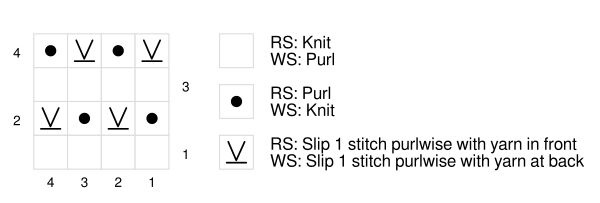
Another Example of a Slip Stitch Pattern

Different Types of Slip Stitch Patterns
There are various types of slip stitch patterns, each offering its own unique characteristics.
- One color, textured patterns: As described above, slip stitches can create a variety beautiful textured fabric.
- Another popular type is the slip-stitch mosaic pattern, which involves slipping stitches from the previous row and working them in a contrasting color. This technique creates a beautiful mosaic effect and is perfect for adding pops of color to your knitting.
- Still another type is the slip-stitch cable pattern, which combines slip stitches and twisted stitches to create the appearance of cables without the need for a cable needle. This technique is excellent for creating intricate cable designs with a twist.
- Additionally, slip-stitch colorwork patterns, such as slip-stitch stripes or slip-stitch fair isle, allow you to incorporate multiple colors in your knitting effortlessly.
Beginner-Friendly Slip Knitting Patterns to Try Right Now
Here is a way to practice a slip-stitch pattern and make a cute coaster at the same time using the linen stitch pattern. The linen stitch is not reversible but does look nice on either side.
1. Linen Knit Stitch Pattern
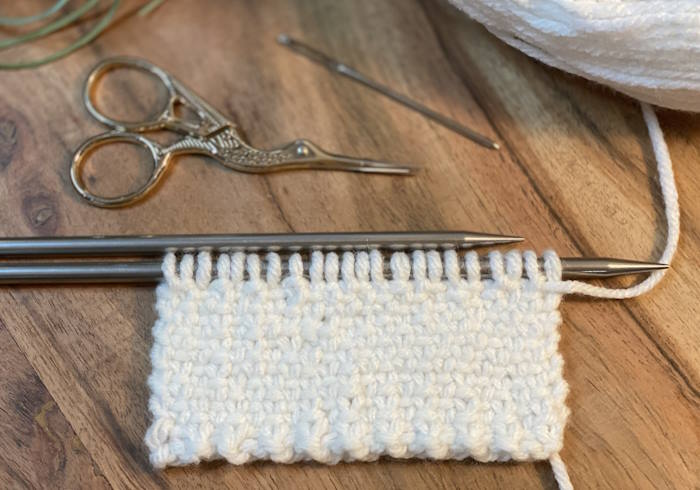
How to Make the Knit Linen Stitch Pattern
2. Mock Ribbing Slip Stitch Design
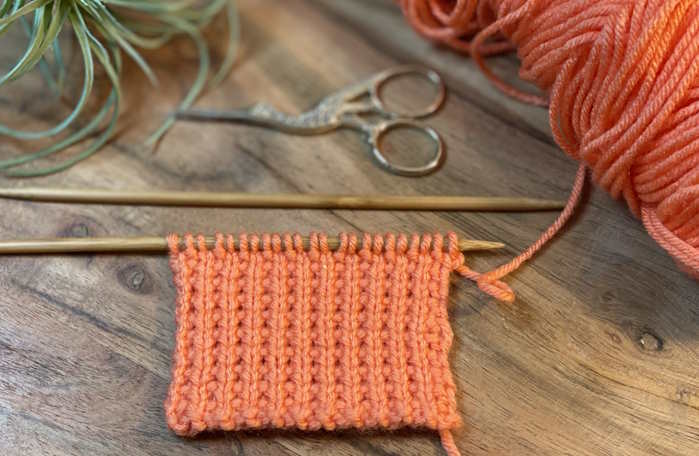 Mock Ribbing Slip Stitch Right Side
Mock Ribbing Slip Stitch Right SideThis knit pattern falls into several catagories including knit and purl stitches and rib stitches. However, I've added it here as an example of a slip stitch pattern because it is easy to master, even for beginners.
The Mock Ribbing Slip Stitch Knit Pattern
3. Vertical Stripe Slip Stitch Pattern
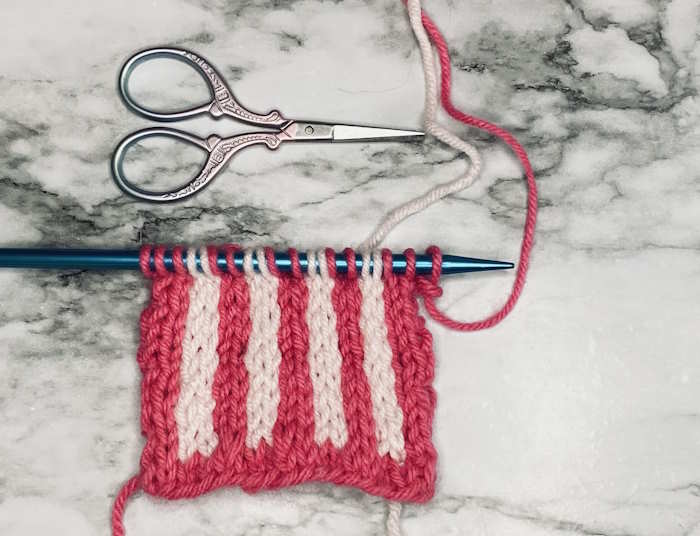
To make this samplier, you will need to cast on a multiple of 4 stitches. I used number 4 worsted weight yarn and number 10 (5 mm) needles.
Cast on with Color B and purl one row. Working a purl row first adds a nice smooth botton border.
CO. 20
CA = Light Pink yarn (Or colors of your choice)
CB = Dark Pink yarn
Next, continue to the pattern repeat below.
Row 1 (RS): With A, k1, * sl 2 wyib, k2; rep from *, end sl 2, k1.
Row 2: With A, k1, * sl 2 wyif, p2; rep from *, end sl 2, k1.
Row 3: With B, k1, * k2, sl 2 wyib; rep from *, end k3.
Row 4: With B, k1, * p2, sl 2 wyif; rep from *, end p2, k1.
Repeat rows 1-4 until the desired length has been reached.
Finish with one more purl row and then bind off and weave in ends.
4. Knit Stamen Stitch Pattern & Free Pattern
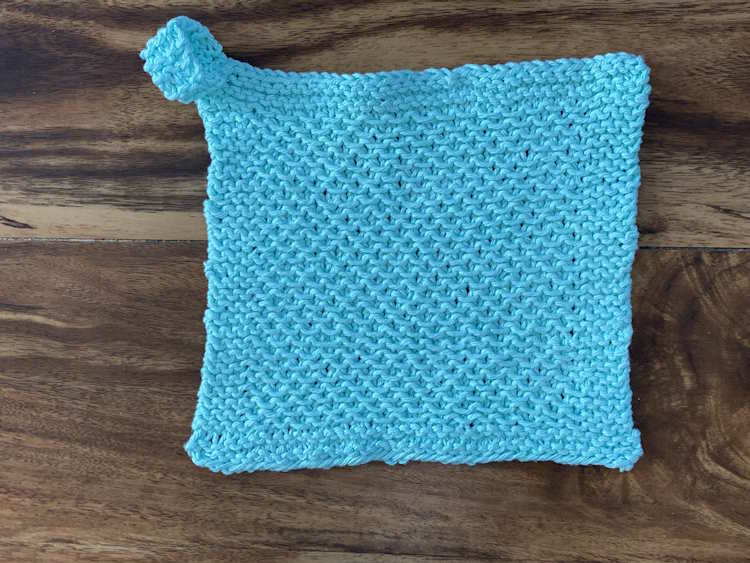 Knit Stamen Stitch Dishcloth
Knit Stamen Stitch DishclothThis is a very easy pattern if you are just getting started with slip stitches. It requires alternating slipping stitches purlwise and then knitting a stitch. Every other row is entirely made of knit stitches. Since each slipped stitch is followed by a knit stitch, the floats you create are easy to manage and thus you shouldn't have too much trouble with tension.
Learn how to make the Knit Stamen Stitch and Dishcloth
5. Double Woven Stitch Pattern
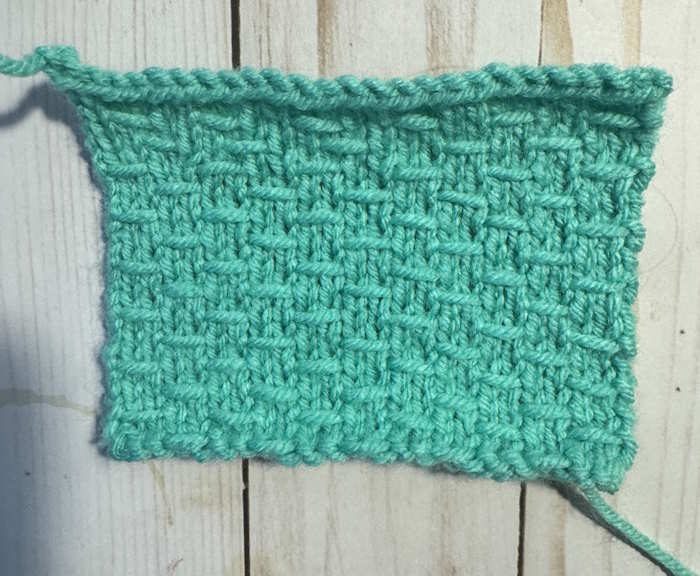
This lovely knit stitch pattern is an easy example of slip stitch knitting. Slip stitches are made by slipping stitches from the left needle to the right needle without knitting or purling the stitch.
This results in a fabric where the slipped stitch looks like a bar that floats on the side of the fabric where the slipped stitches were made.
Double Woven Knit Stitch Tutorial
6. Half-Linen Knit Stitch Pattern
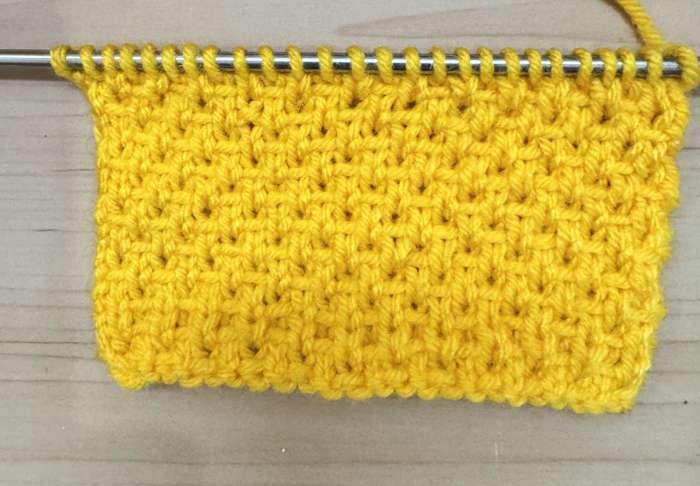
The half-linen knit stitch pattern is a woven stitch created with slip stitches to produce a tight, dense fabric, but not quite as tight as the Linen Stitch.
So, it is a great compromise for projects that need a woven look but don’t need the tight fabric of the linen stitch.
Half-double knit stitch pattern
7. Cartridge-Belt Rib
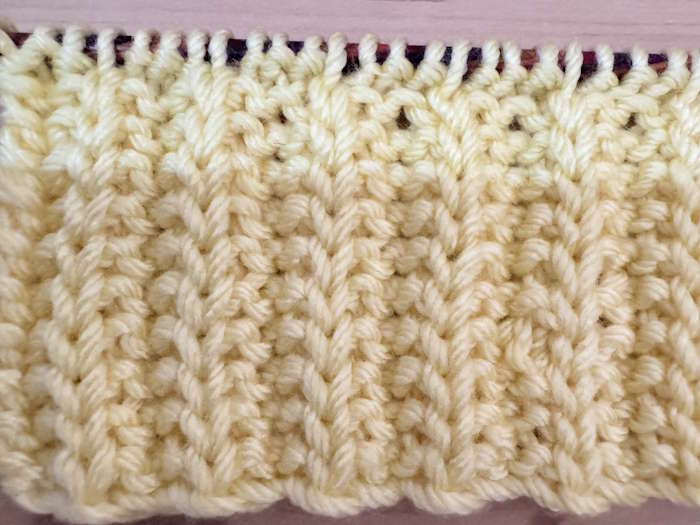 Cartridge-Belt Rib Stitch
Cartridge-Belt Rib StitchIf you hate to purl but need to make a rib stitch, the cartridge belt rib stitch is perfect for you. You must know how to make the knit stitch, but the slip stitches replace all purl stitches.
Cartridge-Belt Rib Stitch Tutorial
8. Slip Stitch Rib
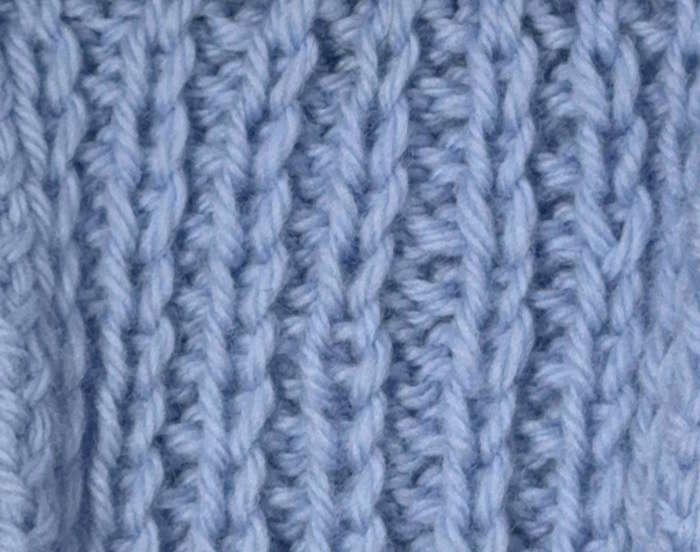 Slip Stitch Rib
Slip Stitch RibThis is one of the easiest slip stitch patterns you will find. With only a two row repeat, and knits and purls, it's the perfect introduction to slip stitches for the beginner.
Whelk Stitch
 Knit Whelk Stitch
Knit Whelk StitchThis stitch pattern uses a series of slip stitches to create a fabric that resembles the sea whelk. It is worked on a four-row repeat and a stitch repeat of multiples of 4 plus 3.
Tips for Creating Stunning Designs with Slip Stitch Patterns
To create stunning designs with slip stitch patterns, consider the following tips:
- Choose the Right Yarn: Opt for a yarn that showcases the texture and color changes of slip stitch patterns. Variegated or gradient yarns can add depth and dimension to your designs. However, if you are aiming for a highly textured fabric where stitch definition is important, a solid color may be your best bet. I prefer a thicker yarn such as a number 5 or 6, bulky or super bulky. PLUS, I always select knitting needles that are a size or two larger as many slip stitch patterns tend to create thick fabric.
- Practice Tension: Slip stitch patterns often require a looser tension to allow the slipped stitches to stand out. Experiment with your tension until you achieve the desired effect. This was my biggest challenge
- Experiment with Colors: Slip stitch patterns are an excellent opportunity to play with colors. Try different color combinations to create unique and eye-catching designs. If making something for your home, pick two colors that compliment each other and would work well with your current decor.
- Combine with Other Stitch Patterns: Don't be afraid to mix slip stitch patterns with other stitch patterns, such as garter stitch or ribbing, to create interesting textures.
- Block Your Work: Blocking is essential to enhance the stitch definition and even out the fabric. Take the time to block your slip stitch projects for a polished and professional finish. Most slip stitch patterns are thick and compact, most do not curl, so you may be tempted to avoid the blocking step. Blocking always make your work look more professional.
Knitting Techniques for Working with Slip Stitch Patterns
Working with slip stitch patterns requires a few specific techniques to achieve the desired results. Here are some key techniques to keep in mind: Here are a few tips to keep in mind.
- Carrying Yarn: In slip stitch colorwork patterns, it's essential to carry the yarn not in use loosely across the back of the work. This prevents the fabric from puckering and allows for smooth color transitions. When changing colors twist the two strands of yarn before beginning the new row.
- Twisting Stitches: Some slip stitch patterns may require twisting the slipped stitch on the subsequent rows. This creates a more defined and elongated stitch, adding to the overall design. If the pattern does not call for twisted stitches, be sure all of your stitches are knit/purl or slipped properly.
Remember how stitches rest on the needle. There is always two legs of each stitch, The leg closest to you and the one on the other side of the needle. In proper formation, the leg closest to you should also be the leg closest to the working stitches.
Popular Slip Stitch Patterns for Beginners
If you're new to slip stitch patterns, there are several beginner-friendly options to get you started. Here are a few popular patterns:
- Slip Stitch Dishcloth: This simple pattern combines slipped stitches with garter stitch to create a textured and absorbent dishcloth. It's an excellent project for practicing slip stitch techniques. Likewise, if you want to tackle something a little more challenging, a place mat or small doilie lends themselves to slip stitch designs.
- Slip Stitch Hat: Knitting a hat with slip stitch patterns allows you to experiment with color changes and create a unique design. Choose a pattern that incorporates simple slipped stitch motifs for a manageable project.
- Slip Stitch Scarf: A slip stitch scarf is a versatile accessory that can showcase a variety of slip stitch patterns. Start with a basic slip stitch stripe pattern and gradually explore more complex designs.
Advanced Slip Stitch Patterns for Experienced Knitters
For experienced knitters looking for a challenge, advanced slip stitch patterns offer endless possibilities. Here are a few examples:
- Slip Stitch Lace Shawl: Combine slip stitches with lace motifs to create an intricate and delicate shawl. This pattern requires careful attention to detail but results in a breathtaking finished piece. Plan to use needles several sizes larger than you normally would.
- Slip Stitch Colorwork Sweater: Knitting a sweater with slip stitch colorwork allows you to showcase complex color patterns without the need for stranded knitting. Choose a pattern that incorporates multiple slip stitch motifs for a visually stunning garment.
- Slip Stitch Cable Blanket: This pattern combines slip stitches with cable techniques to create a cozy and visually appealing blanket. The combination of textures and colors makes for a truly remarkable project.
Conclusion:
Slip stitch patterns offer a world of possibilities for knitters of all skill levels. Whether you're a beginner looking to add texture to your projects or an experienced knitter seeking intricate designs, slip stitch patterns are a fantastic technique to explore.
With countless variations and resources available, you can create stunning designs that showcase your knitting skills and artistic flair. So, grab your needles, choose a slip stitch pattern that inspires you, and elevate your knitting to new heights.









